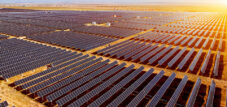Economic efficiency of photovoltaic systems
Language selection 📢
Published on: September 28, 2020 / update from: September 28, 2020 - Author: Konrad Wolfenstein
Since 2017, 600 MW has been awarded annually through tenders for systems over 750 kW. For the years 2019 to 2021, a further 4 GW will be awarded through special tenders.
Electricity from open-space systems is subsidized via the Renewable Energy Act (EEG). The remuneration for this type of system was lower than for photovoltaic systems that are mounted on or on buildings.
In 2009 the remuneration was 31.94 cents per kilowatt hour (kWh) of electricity fed in; in 2010 it fell to 28.43 cents for new systems. As of January 2013 it was 11.78 cents, falling with discounts of 2.5% per month. The 2014 amendment to the EEG stipulated that the level of funding for open-space photovoltaic systems should in future be determined in tenders by the Federal Network Agency, instead of the previous feed-in tariffs determined by law. The implementation took place in the regulation on the tendering of financial support for open space systems of February 6, 2015 (Open Space Tender Ordinance). With the EEG 2017, these tenders are regulated by law. Smaller PV systems up to 750 kWp receive a legally determined remuneration without tendering.
The first bidding date was April 15, 2015 with an advertised quantity of 150 megawatts. The tender volume was several times oversubscribed. The Federal Association for Renewable Energy expressed the fear that citizens' cooperatives and systems could be pushed out of the market because, due to their lower capital strength, they have to make fewer advance payments and can bear fewer risks.
Tenders have been criticized because international experience and economic models suggest that the desired goals of cost efficiency, expansion goals and diversity of actors are thwarted. The pilot model for ground-mounted PV systems was intended to test the practical impact of tenders in the field of renewable energies.
Subsidy-free solar parks : Solar parks are increasingly being built without government subsidies. These projects do not claim any additional market premium from the EEG levy. In 2018, the Viessmann company built a solar park with an output of 2 MW next to its headquarters in Allendorf (Eder), which is refinanced through its own electricity consumption. In 2019, EnBW Energie Baden-Württemberg (EnBW) announced a series of large solar parks that will only pay for themselves through the sale of electricity on the market. Among other things, the Weesow-Willmersdorf solar park is to be built on an area of 164 hectares, the largest solar park in Germany by 2020. The final investment decision for the 180 MW solar park was made in October 2019; EnbW estimates the costs to be in the high double-digit millions. In Marlow, Energiekontor is planning to build a solar park with an output of 80 MW on an area of 120 hectares. The electricity generated there is purchased by EnBW through a long-term supply contract. At Barth Airport, BayWa re renewable energy is building a subsidy-free PV system with 8.8 MW that uses the infrastructure in the existing solar park.
Similar projects exist for the lignite mining areas in the Rhineland and eastern Germany.
Through economies of scale and synergies, large solar parks can reduce the cost of electricity generation to such an extent that EEG remuneration is no longer necessary. The fall in the price of solar modules contributed to this.
Suitable for:
The EEG in Germany only provides for the application of the remuneration rates for certain open spaces (§ 37, § 48 EEG 2017):
- Sealed surfaces. A seal is when the surface of the floor is sealed. Therefore, electricity from systems on roads, parking spaces, landfill areas, embankments, storage and parking areas and the like is also compensated.
- Conversion areas for commercial, traffic, residential or military use. Conversion areas can include, for example, waste dumps, former open-cast mining areas, military training areas and ammunition depots.
- Areas along motorways or railways at a distance of up to 110 meters.
- Arable land and grassland, only if they are located in a disadvantaged area in accordance with Directive 86/465/EEC and have been approved for PV use by the federal states.
The substructure of solar power plants usually only seals a fraction of the natural surface, often less than 0.05% of the actual ground area. The space between the individual rows, which is required to counteract shading of individual rows of modules when the sun is low, contributes to an improvement in ecological quality.
Before the start of construction, open space systems usually go through an approval process in the municipality. In order to be able to use an area, it must be changed to a “special area of Solar” in the land use plan. A development plan is also necessary that creates building law on the corresponding area. The municipality is responsible for the land use planning. It checks space meaning and environmental compatibility of the project and is intended to include all citizens and sponsors of public issues (TÖB). In addition to system size, surface consumption and technology, an important basis for decision -making is the client's green order plan. It describes how the planned open space system integrates into the landscape and it is to be ecologically upgraded. After hearing all parties involved, the municipality passes the development plan. The building permit then takes place.
Suitable for:
Open spaces and environmental protection : Together with the nature conservation organization NABU, the Solar Industry Association (UVS) published a catalog of criteria for the nature-friendly construction of open space systems in 2005. Accordingly, areas with previous pollution and low ecological importance should be preferred and exposed locations on clearly visible hills should be avoided. The elevation should be designed in such a way that extensive use and maintenance of the vegetation, e.g. B. through sheep grazing remains possible. The use of pesticides and manure should be avoided. Nature conservation associations should be involved in planning at an early stage; if necessary - e.g. B. in IBAs (Important Bird Area) – carry out an compatibility assessment. Monitoring documents the development of the natural balance in annual inspections after construction. The ecological criteria formulated here go beyond the legally required minimum. This voluntary commitment should be taken into account by project developers and operators when choosing the location and operating large-scale solar systems built at ground level.
Studies from 2013 show that solar systems have a high contribution to regional biodiversity and that the installation of a solar park can significantly improve the ecological value of the area compared to arable or intensive grassland use. In addition to the age of the facilities, the proximity to supply biotopes, which should preferably be less than 500 m, is the decisive factor for immigration and the biodiversity of the facility. The oldest facility with the greatest biotope diversity in the surrounding area proved to be the best facility in terms of biological diversity in the study. After just a short time, the extensification of agricultural cultivation led to an immigration of butterflies and an increasing diversity of plants. In addition, the respective use of the solar park is very important for ecological diversity: excessive grazing has a negative impact. In particular, some mobile animal species such as butterflies repopulated the areas after a short time. In four of the five solar parks examined, the biodiversity of animals increased significantly compared to the previously intensive agricultural use.


























